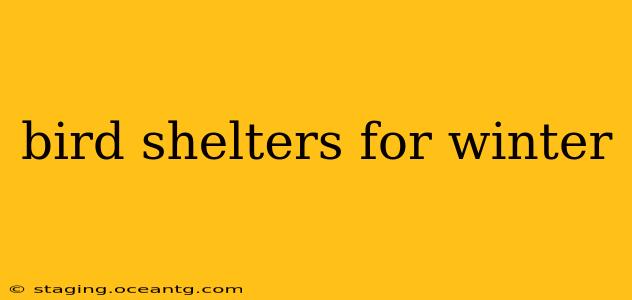Winter can be a harsh time for birds, with food scarcity and freezing temperatures posing significant threats. Providing winter shelters can dramatically increase their survival chances. This guide offers comprehensive advice on creating effective bird shelters, addressing common questions and concerns.
What kind of shelter do birds need in winter?
Birds require shelter that protects them from the elements, specifically wind, rain, snow, and extreme cold. The ideal shelter provides a degree of warmth, a safe place to roost, and some protection from predators. This could range from simple natural shelters like dense evergreens to more elaborate, human-made structures. The type of shelter needed will vary depending on the species of bird and the severity of the winter weather. Smaller birds, for example, will need more protection than larger, hardier species.
What materials are best for building a bird shelter?
The best materials are natural, weather-resistant, and safe for birds. Avoid using treated lumber or materials that could leach harmful chemicals. Consider these options:
- Wood: Untreated wood is a great option, providing insulation and structural support.
- Twigs and branches: These can be used to create a natural, rustic shelter.
- Straw: Provides excellent insulation, but make sure it's dry to avoid dampness. Don't use hay, as it can harbor insects and parasites.
- Pine cones and leaves: These can be added for extra insulation and a more natural feel.
How can I make a simple bird shelter?
A simple bird shelter can be as easy as creating a small brush pile in a sheltered area of your yard. This provides a natural haven for birds to seek refuge. Alternatively, you can construct a more elaborate structure using the materials listed above:
- A birdhouse with a small entrance: Ensure the entrance hole is appropriately sized for the birds you wish to shelter.
- A simple wooden box: Line the box with insulating materials such as straw or pine needles.
- A sheltered area under a deck or overhang: Adding a small platform or brush pile in this location can provide additional protection.
Where should I place a bird shelter?
Location is key to the effectiveness of a bird shelter. Consider these factors:
- Protection from the elements: Choose a location sheltered from wind, rain, and snow. A south-facing location can also help to maximize solar warmth.
- Predator protection: Place the shelter away from easily accessible areas for cats and other predators. Consider using strategically placed branches or other natural barriers for added security.
- Proximity to food sources: Locate the shelter near feeders or natural food sources to minimize the distance birds need to travel in harsh weather.
How do I make a bird shelter safe from predators?
Predators pose a significant threat to birds seeking shelter. Several measures can mitigate this risk:
- Elevated placement: Place the shelter high off the ground, making it more difficult for ground predators to access.
- Solid construction: Use sturdy materials to prevent predators from easily tearing into the shelter.
- Strategic placement: Place the shelter in a location that provides natural barriers from predators.
- Minimize open spaces: The entrance to the shelter should be small and well-protected.
What are some natural winter shelters for birds?
Many natural features can serve as effective winter shelters for birds. These include:
- Dense evergreen trees and shrubs: These provide excellent protection from wind, rain, and snow.
- Hollow trees and logs: These offer warmth and shelter from predators.
- Rock crevices and overhangs: These offer a degree of protection from the elements.
By providing supplemental winter shelter, you can significantly improve the chances of survival for local bird populations. Remember that the key is to offer a safe, warm, and protected space, mimicking the natural shelters birds would seek in the wild.
